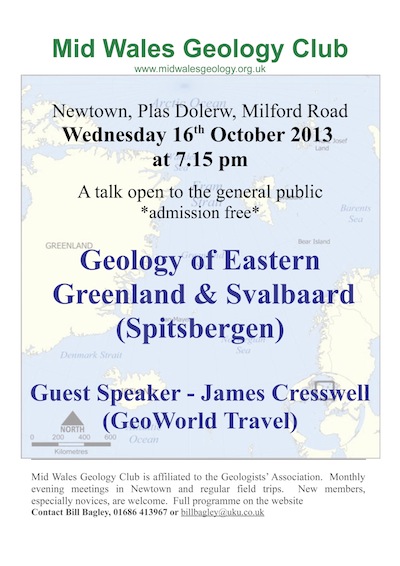Saturday 26th October 2013
The last indoor meeting was a talk given by James Cresswell of “GeoWorld Travel”. This was a highly informative and enjoyable talk.
Greenland has some of the oldest rocks on earth which are found in the Isua Greenstone Belt and have been aged at between 3.7 - 3.8 GA. Greenland forms part of the North American Plate whilst Svalbard forms part of the European plate. It is this relative difference in their positions which have produced the differences that can be seen in their geology. With this in mind, commencing at 4.6 GA James worked chronologically through geological time discussing plate movements, glaciation and rises and fall in sea level, sedimentation and orogenesis, the results of which can be seen in their geology. This detailed explanation along with superb photographs of spectacular rock formations made for a very pleasurable talk.
The next indoor meeting will be held on Wednesday November 20th where Professor Bill Fitches will give a talk entitled: “Greenland’s Ancient Gneissic Rocks”
Thursday 26th September 2013
The next indoor meeting will be held on 16th October. The speaker is James Creswell from GeoWorld Travel who will speak on the Geology of Eastern Greenland and Svalbaard.

Monday 23rd September 2013
Field Trip to The Cat’s Back
22 September 2013 we enjoyed a splendid day walking up the Cat’s Back (Crib y Garth), Black Mountains, on the western edge of Brecon Beacons National Park. This spectacular ridge (arête) created in the Ice Age rises 240 metres from the parking below. Duncan Hawley’s usual ceaseless flow of information and careful tutoring revealed the evidence of the vast plains and meandering rivers of the early semi-arid Devonian period and drew us into discussion of several phenomena on which consensus has not yet been reached.
Monday 9th September 2013
Change to indoor meeting Wednesday 18th September
The talk due to be given by Professor Bill Fitches will now take place on Wednesday 20th November. Therefore the next meeting on 18th of September will be the Member’s evening. Talks will be given by Tony Thorpe and Colin Humphrey.
Sunday 1st September 2013
Indoor Meeting 21st August 2013
Talk given by member Dr Sara Metcalf on the fossil history of sharks and rays.
Sara gave an excellent talk in which she explained that there is a 400 million year fossil history of sharks. Thought to have arisen during the Devonian period there is some evidence that they could have evolved much earlier even into the Ordovician. There are about 1000 living species. She then went on to describe their morphology and how they differ from other fish. One major difference residing in the fact that they have a cartilaginous and not bony skeleton. This, of course leads to problems of fossilisation such that the main shark fossils are of teeth, dermal denticles,fin spines and calcified vertebrae. Trace fossils are rare but coprolites are frequent.
The most important genus during the Palaeozoic was that of Cladoselache, fossils of which can be found in the Cleveland Shales around Lake Erie in North America. By the start of the Carboniferous sharks had diversified and proliferated greatly and then remained relatively stable until the mass extinction at the end of the Permian. Two groups now emerged one moving into fresh water whilst the other remained marine. By the late Triassic the first modern sharks appear. These had a much more flexible jaw which increased their advantage when in competition for food.
By the Cenozoic Era all the modern sharks are present and also the biggest shark of all time Carcharodon Megalodon which is regarded as one of the largest and most powerful predators in vertebrate history.
